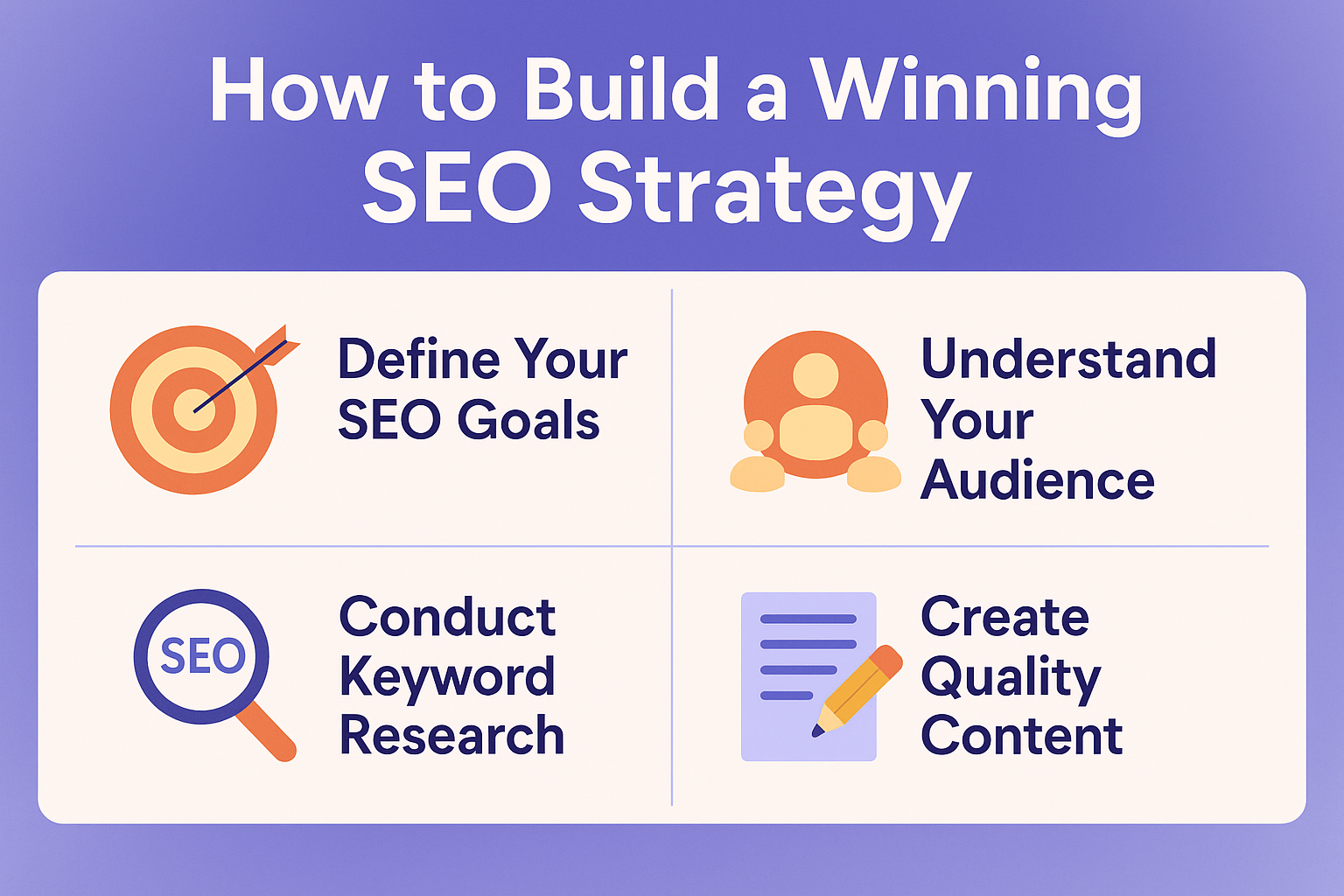 How to Build a Winning SEO Strategy
How to Build a Winning SEO Strategy
In today’s digital age, simply having a website is not enough. If your potential customers can’t find you online, you’re losing business to competitors. That’s where a solid SEO (Search Engine Optimization) strategy comes in. SEO isn’t just about ranking higher on Google—it’s about understanding your audience, creating valuable content, and improving user experience to attract and convert visitors.
In this blog, we’ll walk through the steps to build a winning SEO strategy that brings long-term results for your business or personal brand.
1. Understand Your Goals
Before jumping into technical tactics, start by defining what success looks like for you.
Are you aiming for more website traffic?
Do you want to generate more leads or sales?
Are you trying to increase your brand’s visibility?
Your SEO goals should align with your overall business objectives. For example, an eCommerce store might focus on ranking product pages, while a local service provider might want to appear in “near me” searches.
2. Know Your Audience
You can’t optimize content effectively if you don’t understand your target audience.
Start by asking:
What are their problems or pain points?
What questions are they typing into search engines?
What type of content do they consume?
Creating detailed buyer personas helps you understand user intent. This will guide your keyword research, content creation, and site structure.
3. Do In-Depth Keyword Research
Keywords are the backbone of SEO. They connect your content with what people are searching for.
Here’s how to find high-impact keywords:
Use tools like Google Keyword Planner, Ubersuggest, or Ahrefs.
Focus on long-tail keywords with less competition and high intent (e.g., “best running shoes for flat feet” instead of just “shoes”).
Look at what keywords your competitors are ranking for.
Organize keywords into themes or clusters—this helps you plan content that addresses multiple user queries within one topic.
4. Create High-Quality, Relevant Content
Search engines prioritize content that’s helpful, relevant, and up-to-date.
Here are some tips:
Write for humans first, not just search engines.
Use your target keyword naturally—especially in the title, first 100 words, headings, and meta description.
Add supporting content: FAQs, statistics, examples, and visuals.
Include internal links to related articles and external links to credible sources.
Quality content builds authority, keeps readers engaged longer, and increases the likelihood of backlinks—all crucial for SEO.
5. Optimize On-Page SEO Elements
On-page SEO involves the elements you control on your website. Focus on:
Title Tags: Keep them under 60 characters and include your main keyword.
Meta Descriptions: Entice users to click with a clear and concise summary.
Header Tags (H1, H2, H3): Structure your content for readability.
Image Alt Text: Helps with accessibility and can boost image search rankings.
URL Structure: Use clean, keyword-rich URLs (e.g., www.example.com/seo-strategy)
Make sure your content is mobile-friendly, loads fast, and uses responsive design.
6. Build a Strong Technical SEO Foundation
Without a technically sound website, your content might never get indexed or ranked.
Key technical elements to focus on:
Crawlability: Ensure search engines can access your site with a proper sitemap and robots.txt file.
Site Speed: Use tools like Google PageSpeed Insights to identify and fix slow-loading pages.
Secure Website (HTTPS): Google favors secure websites.
Mobile Optimization: Use a responsive design that adapts to all screen sizes.
Fix Broken Links: Regularly check for 404 errors and redirect them appropriately.
A solid technical base is essential to support your content and ensure a smooth user experience.
7. Build Quality Backlinks
Backlinks (links from other websites to yours) remain one of the top ranking factors in SEO.
Here’s how to earn them:
Guest Blogging: Write valuable content for reputable sites in your industry.
Create Shareable Assets: Infographics, research reports, and case studies get more links.
Engage in PR: Reach out to journalists or bloggers with relevant pitches.
List in Directories: Especially for local SEO, ensure you’re listed in Google Business Profile, Yelp, and industry-specific directories.
Remember: Quality beats quantity. One link from a respected site is worth more than dozens from irrelevant sources.
8. Monitor and Measure Results
SEO isn’t a “set it and forget it” strategy. You need to track performance and make adjustments regularly.
Tools like:
Google Analytics (to track traffic and behavior)
Google Search Console (to monitor indexing, performance, and site issues)
SEMrush / Ahrefs (for keyword rankings and competitor tracking)
Look for trends:
Which keywords are driving the most traffic?
Which pages have high bounce rates?
Where are your backlinks coming from?
Use this data to refine your content, adjust keywords, and improve site performance.
9. Stay Updated with SEO Trends
Search engine algorithms are constantly evolving. What worked last year might not work now.
Stay current by:
Following SEO blogs like Moz, Search Engine Journal, and Neil Patel.
Watching Google Search Central updates.
Testing new strategies (like voice search optimization or schema markup).
Adaptability is key in SEO—those who keep learning will stay ahead of the curve.
10. Be Patient and Consistent
SEO takes time. It may be weeks or even months before you see significant improvements. But the rewards—organic traffic, credibility, and long-term ROI—are worth it.
Avoid shortcuts like buying backlinks or keyword stuffing. Google penalizes such practices. Focus on building genuine value for your audience and improving your site step-by-step.
Final Thoughts
A winning SEO strategy doesn’t rely on luck—it’s built on research, execution, and consistency. Understand your audience, create content they care about, and make it easy for search engines to find and rank your pages.
Start with the basics, track your progress, and continue refining your strategy. With time and effort, SEO can become your most powerful digital marketing channel.